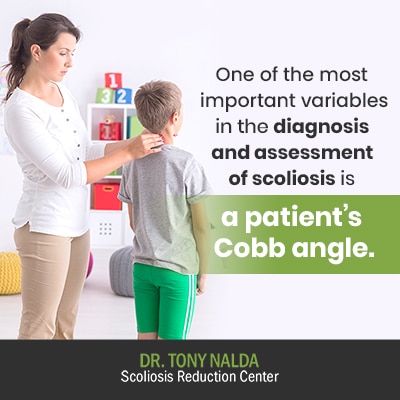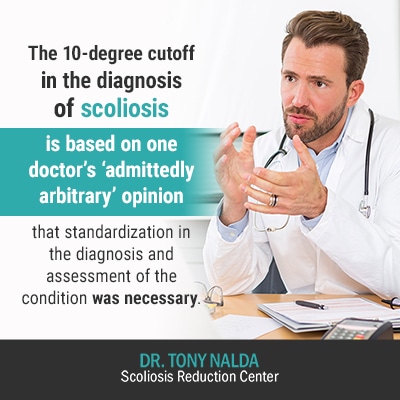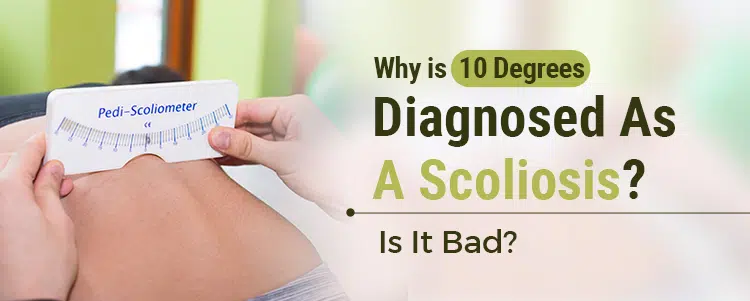Not only are there different types of scoliosis a person can develop, the condition also has a wide range of severity levels, including mild to very severe. If an abnormal sideways spinal curvature rotates and measures at 10 degrees or more, this is considered a ‘true scoliosis’. Keep reading to find out how the 10-degree cutoff was determined.
In addition to an abnormal spinal curvature having to include rotation, it also has to have a minimum Cobb angle measurement of 10 degrees to be considered a ‘true scoliosis’. This is, quite simply, where the cutoff point was decided to regulate the diagnostic process.
In order for a scoliosis diagnosis to be given, certain parameters have to be met. Before we get into the specifics of how the 10-degree cutoff was determined, let’s first take a minute to discuss the condition in general terms.
What is Scoliosis?
Looking at a healthy spine from the side reveals that it is naturally curved in a soft ‘S’ shape; it would appear straight if viewed from the front or back.
The spine’s natural curvatures make it stronger, more flexible, and better able to absorb and distribute stress and weight evenly.
There are a number of spinal conditions a person can develop, most involving a loss of the spine’s healthy curves which can affect its overall health and function.
Scoliosis involves an abnormal sideways spinal curvature that rotates and meets the size requirement of 10+ degrees. The condition is progressive, meaning its nature is to get worse over time, especially if left untreated, or not treated proactively.

One of the most important variables in the diagnosis and assessment of scoliosis is a patient’s Cobb angle.
Condition Severity: Cobb Angle
One of the reasons that scoliosis treatment plans have to be fully customized is that no two cases are the same, and this is largely due to the condition’s severity range, determined by the size of the curvature: Cobb angle.
Part of the diagnostic and assessment process commonly includes a scoliosis X-ray, and this involves a lot of precise measurements that guide the design of treatment plans moving forward.
A patient’s Cobb angle is a measurement taken by drawing lines from the tops and bottoms of the most-tilted vertebrae of the curvature: apex of the curve. This involves multiple vertebrae, and the intersecting lines form an angle that’s measured in degrees and tells me how far out of alignment a patient’s scoliotic spine is.
While every case is different, in general, the higher the Cobb angle, the more severe the condition is and the more likely it is to produce noticeable symptoms such as pain (more common in adults) and postural changes that affect the body’s overall symmetry:
- Mild scoliosis: Cobb angle measurement of between 10 and 25 degrees
- Moderate scoliosis: Cobb angle measurement of between 25 and 40 degrees
- Severe scoliosis: Cobb angle measurement of 40+ degrees
- Very-severe scoliosis: Cobb angle measurement of 80+ degrees
As you can see from the range of Cobb angle measurements, scoliosis is a highly-variable condition, and this leads us nicely into addressing a common condition-related question: “Is a 10 degree scoliosis bad?”
Is a 10 Degree Scoliosis Bad?
So how bad is it to be diagnosed with mild scoliosis at 10 degrees?
As mentioned, scoliosis ranges greatly in severity, and as it’s progressive, even if a condition is initially diagnosed as mild with a 10-degree curve, this is not indicative of where it will stay; scoliosis is not a static condition, and if left untreated, or not treated appropriately, that 10-degree curve will progress to a larger size at some point.
Current estimates from the Scoliosis Research Society show that close to seven million people are living with scoliosis in the United States alone, and keep in mind these are only ‘known’ diagnosed cases and only include the States.
If there was a way to estimate the number of people around the world living with diagnosed, and undiagnosed, scoliosis, that number would increase exponentially.
Clearly, scoliosis is a highly-prevalent spinal condition, which is why it was so important, and necessary, to determine a cutoff point to regulate the diagnostic process.
Imagine how skewed results and studies would be if different doctors and scientists were using their own parameters to determine whether or not a scoliosis diagnosis is given.
In addition, as the most-prevalent form of the condition is adolescent idiopathic scoliosis (AIS), diagnosed between the ages of 10 and 18, and the biggest trigger for progression is growth, early detection is particularly beneficial for this age group; screening is an important part of that.
While not so common any more, in the past, many American schools automatically screened for scoliosis because of the condition’s prevalence and the treatment benefits associated with early detection.
Just as the screening process has to be streamlined with certain indicators warranting recommendations for further testing, the diagnostic process was also in need of consistency.
So while a 10-degree scoliosis isn’t particularly ‘severe’, it does indicate the need for monitoring and proactive treatment in order to prevent that 10-degree curve from becoming a larger curve.
Before moving on to explain how the 10-degree cutoff for a scoliosis diagnosis was reached, I’d like to answer another common question because the answer has guided my treatment approach and career as a scoliosis chiropractor: “What degree of scoliosis needs treatment?”
What Degree of Scoliosis Needs Treatment?
The answer to this question will vary based on whom you ask and what treatment approach they are basing their answer on.
There are two main treatment approaches for scoliosis: conservative and traditional. As mentioned earlier, there are benefits associated with early detection in terms of treatment success.
While no treatment results are guaranteed, treating scoliosis while it is mild means treating a curvature that is smaller, less rigid, has not yet progressed significantly, and before the body has fully adjusted to the abnormal spinal curve’s presence; however, those benefits are only available to patients receiving care from a doctor that believes in proactive treatment applied early on.
Here at the Scoliosis Reduction Center®, patients benefit from a conservative chiropractic-centered treatment approach that values proactive treatment applied as close to the time of diagnosis as possible.
I believe that with a progressive condition like scoliosis, you strike while the iron is hot, so to speak. Waiting for a condition to become more severe before applying treatment, in my opinion, is wasting valuable treatment time; yet, this is what the traditional approach to scoliosis treatment does.
Along the traditional path of treatment, monitoring is recommended for cases of mild scoliosis, and it’s not until it progresses into the moderate stage that treatment is applied, in the form of bracing, to stop further progression.
If progression doesn’t stop and the condition crosses that surgical-level threshold of 40+ degrees, spinal-fusion surgery is commonly recommended.
While any surgical procedure is risky, spinal fusion is an invasive procedure that can impact quality of life post-surgery and comes with the risk of heavy side effects and complications.
Here at the Center, through the use of proactive treatment and an integrative approach that combines multiple forms of scoliosis-specific treatment such as chiropractic care, in-office therapy, custom-prescribed home exercises, and ultra corrective bracing, patients can be spared the hardships associated with further progression and more-invasive forms of treatment.
So to return to the original question of what degree of scoliosis needs treatment: under a proactive conservative approach, any scoliotic curve of 10+ degrees can benefit from treatment.
After all, there is no harm in reducing a mild curve to smaller, but there is potential harm in leaving a mild curve to progress unimpeded and further complicating treatment unnecessarily.
Should I Worry About My Scoliosis?
For those recently diagnosed with scoliosis, it’s natural to wonder how concerned they should be.
To return to the last question regarding when to get treatment, I believe any degree of curvature should be treated proactively; it simply isn’t considered scoliosis until a curvature is at least 10 degrees.
In terms of condition severity, I would say if you are responding proactively with treatment, you should be less worried than someone who is choosing to only monitor their condition while it is still mild.
Patients with mild scoliosis who are following the traditional route are likely to be returning to their treatment-provider at predetermined intervals for physical examination and periodic X-rays to see if, and how much, they are progressing.
Depending on the doctor, these periodic visits can vary from every 3, 6, or even 12 months, and just imagine what could happen in cases of AIS where an adolescent has a large growth spurt in the interim between assessments and progresses rapidly.
While every case is different, it’s also not uncommon for scoliosis progression to go unnoticed, particularly in children and adolescents for whom the condition is not commonly described as painful. This is because in younger patients who have not yet reached skeletal maturity, the spine is experiencing a lengthening motion associated with growth, and this counteracts the main source of scoliosis-related pain: compression of the spine and its surrounding muscles and nerves.
So should you worry about your scoliosis? If monitoring is the only treatment you are undergoing, then, yes, I would be more concerned that progression will be missed and that valuable treatment time is wasted.
While I understand that anyone diagnosed with a progressive spinal condition would be concerned, regardless of condition characteristics and treatment choice, for patients undergoing proactive treatment, I would say they have more control because the necessary course of action is being applied, increasing chances of treatment success.
Here at the Center, I work closely with my patients to ensure they are engaged in their treatment; this empowers them and motivates them once they start to see results. They know that if they work hard, they can impact their condition positively and regain feelings of control over their bodies and, by extension, their lives.
In the end, we all know that worrying won’t change the outcome of anything. In fact, the more worried a person is, the more stressed they are, the more cortisol (stress hormone) the body produces, and that can negatively impact both mental and physical health.
A positive mindset is a big part of treatment success and helps the body respond positively, so I recommend that all scoliosis patients find an outlet for their stress and concerns, and for those needing extra support, here at the Center, we have the resources needed to ensure patients are getting what they need in terms of physical and mental support.
This topic leads us nicely into the last condition-related question I’d like to address: “What degree of scoliosis is normal?”
What Degree of Scoliosis is Normal?
I feel when people ask me about normalcy and scoliosis, what they really want to know is how different degrees of scoliosis commonly affect peoples’ quality of life.
Once a patient is told what their Cobb angle is, they want to know how they rank in terms of condition severity and how life is impacted in terms of being able to carry on with their normal activities and interests.
To this, I say every case is different. In general, the higher the Cobb angle, the more severe the condition, and the more likely it is that the condition can affect different areas of life from pain to postural changes and mobility restrictions.
In the majority of mild cases, scoliosis is not known to cause pain in younger patients, nor is it known to cause significant functional deficits; this is why early detection can be a challenge.
Many of my patients have moderate scoliosis, and that’s because it’s quite common for people to be unaware of having mild scoliosis, and once it has progressed into the moderate condition-severity level, this is when symptoms tend to become more noticeable, such as postural changes and pain (more common in adults).
So what degree of scoliosis is normal? As scoliosis involves having an ‘abnormal’ spinal curvature, no scoliotic spine is ‘normal’ when compared with a healthy spine; however, even in those cases that have progressed past the mild stage and moved into the moderate or severe severity level, there is always hope that patients can have a ‘normal’ existence and quality of life, especially if proactive treatment is applied as close to the time of diagnosis as possible.
Now, let’s talk about how 10 degrees became the abnormal curvature-size cutoff for diagnosing scoliosis.
How the 10-Degree Cutoff for Scoliosis was Determined
As mentioned, in order for a scoliosis diagnosis to be given, certain parameters have to be met: abnormal sideways spinal curvature, with rotation, and a minimum Cobb angle measurement of 10 degrees.
But why 10 exactly? To answer this question, we can refer to an article from 1977 by a Dr. William Kane entitled “Scoliosis Prevalence: A Call for a Statement of Terms.”
In this article, Dr. Kane discusses the problem of variability in the use of different diagnostic cutting points, meaning different medical professionals and scientists were using different curvature degrees to diagnose and assess scoliosis.
This, of course, led to different perspectives on what was considered a ‘true scoliosis’, with one person calculating that 16 out of every 100 people had scoliosis, and another claiming that 3 out of 1,000 had the condition.
When it came to screening, depending on who was conducting the exam and what their standard was, results were inconsistent when it came to determining indicators of the condition.
Dr. Kane saw a need to standardize the management of scoliosis by introducing specific points when the condition would be diagnosed and recommendations for monitoring, bracing, and surgery were made.
To do this, he turned to statistical analysis and ‘log normal distribution’, and this was a graph used to predict the prevalence of scoliosis, of a certain degree, within any given population.
So ultimately, the reason why a 10-degree cutoff point was chosen wasn’t based on any specific scientific evidence that 10-degree curves were more serious than a 5- or 15-degree curve, nor is it based on evidence that 10 degrees is the ideal time to start treatment.

The 10-degree cutoff in the diagnosis of scoliosis is based on one doctor’s ‘admittedly arbitrary’ opinion that standardization in the diagnosis and assessment of the condition was necessary.
Conclusion
While being diagnosed with scoliosis can hardly be described as positive, it doesn’t have to be viewed as all bad. People like Usain Bolt, the world’s fastest man, didn’t let a scoliosis diagnosis slow him down and still went on to earn his Olympic title and world-wide recognition, despite having scoliosis.
In fact, if a patient is diagnosed with scoliosis at 10 degrees, in terms of treatment, this is somewhat fortunate as this means early detection was accomplished and proactive treatment can be applied while the condition is still mild and the curvature is smaller and easier to treat.
In order for an abnormal spinal curvature to be diagnosed as a true scoliosis, it has to have rotation and a minimum curvature size of 10 degrees, and this cutoff point was decided by a Dr. William Kane back in 1977.
As Dr. Kane pointed out the need to standardize the management of scoliosis, this included diagnosis, assessment, and treatment, and the 10-degree cutoff point was a somewhat arbitrary choice, rather than being based on scientific evidence that a 10-degree curve was any more significant/appropriate than other curvature degrees.
Basically, when it comes to what’s considered scoliosis and what’s not, the rotational element is key, as is the minimum curvature size of 10 degrees that still stands as the current diagnostic cutoff point.
Here at the Scoliosis Reduction Center®, I have experience diagnosing, assessing, and treating scoliosis at any age and severity level, and for those wanting to follow a conservative treatment approach that values proactive treatment and the benefits of early detection, our results speak for themselves.





